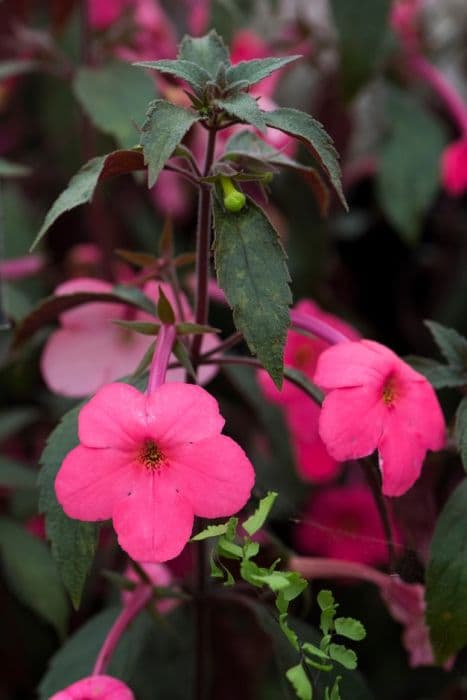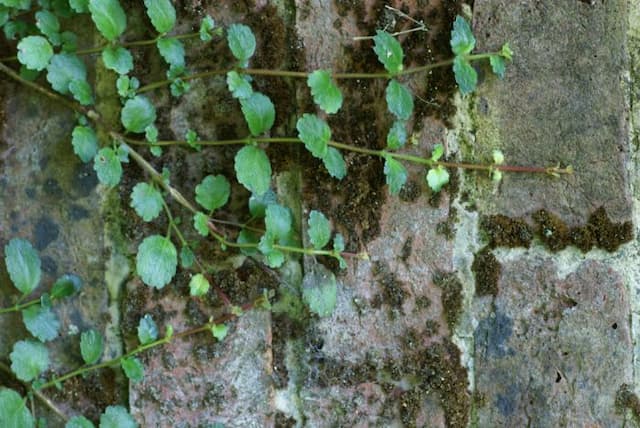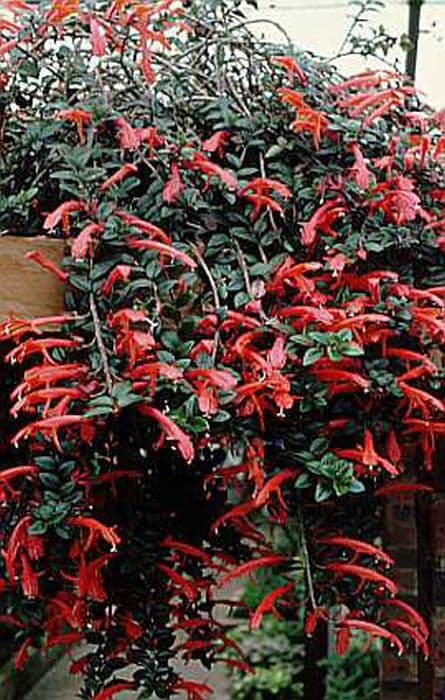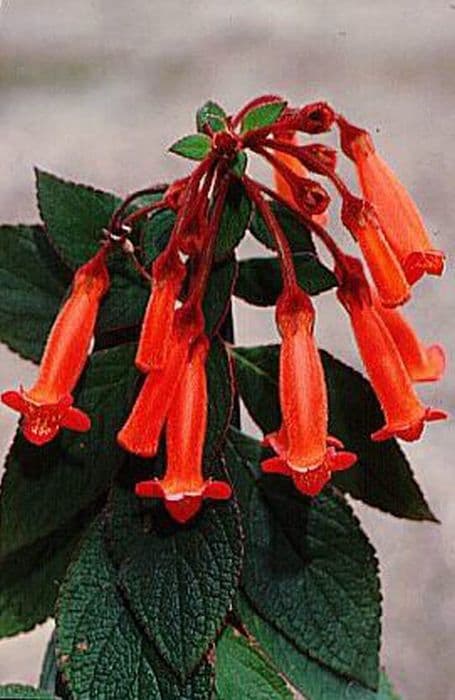Large-flowered Petrocosmea Petrocosmea grandiflora Helmsl.

ABOUT
Petrocosmea grandiflora, commonly known as petrocosmea, is a plant with a distinctive appearance. It features a rosette of lush, rounded, and slightly fleshy leaves, which often have a velvety texture. These leaves can come in various shades of green, sometimes exhibiting a silvery sheen or fine hair-like structures on the surface, giving them a soft, attractive appearance. The plant produces flowers that are comparatively large in relation to its foliage. The blossoms are typically tubular with flared edges and come in a range of colors, often in hues of blue, lavender, purple, or occasionally white. These flowers have a symmetrical shape with a fused petal structure, giving them a somewhat balloon-like appearance before they fully open. The overall impression of the petrocosmea grandiflora is that of a delicate and ornamental plant, with its showy blooms creating a striking contrast against the dense cluster of leaves. The floral display is usually quite pronounced, with multiple blossoms sometimes appearing on a single plant, making it a favored choice for indoor plant enthusiasts and collectors.
About this plant
 Names
NamesFamily
Gesneriaceae
Synonyms
Large-Flowered Petrocosmea
Common names
Petrocosmea grandiflora Helmsl.
 Toxicity
ToxicityTo humans
There is limited information available on Petrocosmea grandiflora, commonly known as Chinese African violet, regarding its toxicity to humans. As with any plant not commonly consumed, it is always best to avoid ingesting it unless it is known to be safe. If someone were to ingest parts of this plant and experience symptoms such as nausea, vomiting, or diarrhea, it would be wise to seek medical attention. However, since there is no specific documented evidence of its toxicity, no definitive symptoms of poisoning can be described for Petrocosmea grandiflora.
To pets
Like the information available on its effects on humans, there is also limited data regarding the toxicity of Petrocosmea grandiflora, or Chinese African violet, to pets. It is not known to be a commonly toxic plant to pets such as cats and dogs, but because its effects are not well documented, it is best to prevent pets from ingesting it. If your pet does consume parts of this plant and shows signs of illness, such as vomiting, diarrhea, or unusual behavior, contact a veterinarian for proper advice and treatment.
 Characteristics
CharacteristicsLife cycle
Perennials
Foliage type
Evergreen
Color of leaves
Green
Flower color
Blue
Height
0.5 feet (15 cm)
Spread
1 feet (30 cm)
Plant type
Herb
Hardiness zones
10
Native area
China
Benefits
 General Benefits
General Benefits- Aesthetic Appeal: Petrocosmea grandiflora, commonly known as Grandiflora, adds visual beauty to gardens and indoor spaces with its showy flowers and attractive foliage.
- Low Maintenance: It requires minimal care, making it suitable for gardeners of all skill levels.
- Attracts Pollinators: The vibrant flowers can attract beneficial pollinators like bees and butterflies to the garden.
- Compact Growth: Its small size makes it ideal for growing in containers or limited spaces.
 Medical Properties
Medical PropertiesThis plant is not used for medical purposes.
 Air-purifying Qualities
Air-purifying QualitiesThis plant is not specifically known for air purifying qualities.
 Other Uses
Other Uses- Miniature landscaping: The compact size of the rosette-forming Petrocosmea grandiflora makes it a suitable choice for creating miniature garden landscapes or fairy gardens.
- Photography subjects: The striking blossoms of Petrocosmea grandiflora can provide a beautiful subject for macro photography, helping photographers capture the intricate details of its flowers.
- Art inspiration: Artists may use the plant as inspiration or a reference for botanical illustrations and paintings, due to its unique floral structure and aesthetics.
- Educational tool: Botany teachers might use Petrocosmea grandiflora as a live example in classrooms to educate students about plant biology and the diversity within the plant kingdom.
- Hobby cultivation: Enthusiasts of rare and exotic plants often grow Petrocosmea grandiflora as a challenge and to add to their collection of unique flora.
- Window displays: Due to its attractive foliage and blooms, the plant can be used to enhance window display designs in homes and small boutiques.
- Feng shui: Some may use Petrocosmea grandiflora in their home decor as part of Feng Shui practice, believing it can bring positive energy to an indoor space.
- Floral arrangements: While not common, the flowers of Petrocosmea grandiflora could potentially be included in small, delicate floral arrangements or terrariums.
- Propagation workshops: Gardeners and plant shops might use Petrocosmea grandiflora in workshops teaching propagation techniques, as it can be propagated by leaf cuttings or division.
- Horticultural shows: This species may be displayed in horticultural or garden shows, highlighting rare and interesting plant varieties for enthusiasts and the general public.
Interesting Facts
 Feng Shui
Feng ShuiThe Petrocosmea is not used in Feng Shui practice.
 Zodiac Sign Compitability
Zodiac Sign CompitabilityThe Petrocosmea is not used in astrology practice.
 Plant Symbolism
Plant Symbolism- Rarity: Petrocosmea grandiflora, commonly known as Grandiflora Petrocosmea, is not a widely recognized plant, which could symbolize uniqueness or something precious and rare.
- Beauty: Its aesthetic appeal with large, attractive flowers may represent beauty and admiration.
- Delicacy: The delicate structure of the plant might stand for fragility or the need for careful handling in relationships or situations.
- Charm: The charming appearance of the Grandiflora Petrocosmea can symbolize enchantment or the power of allure.
 Water
WaterFor the Chinese Pansy or Petrocosmea grandiflora, it's crucial to maintain moist but not waterlogged soil. Water the plant when the top inch of the soil feels dry, usually every 5 to 7 days, depending on the humidity and temperature of your environment. Use lukewarm water and gently pour it onto the soil until it starts to drain out of the bottom; this may be around 8-16 ounces for a standard pot. Do not let the plant sit in water; empty the saucer underneath after watering. During winter, reduce watering to prevent root rot.
 Light
LightThe Chinese Pansy thrives best in bright, indirect light. Position it near a north or east-facing window where it can receive plenty of light without the harshness of direct sun which can scorch its leaves. An ideal spot would be behind a sheer curtain, which diffuses the intensity of sunlight.
 Temperature
TemperaturePetrocosmea grandiflora, or Chinese Pansy, prefers a temperature range between 60°F and 75°F. It's important to protect the plant from temperatures below 50°F, as cold drafts or frost can severely damage it. Ideally, maintain a consistent temperature within the preferred range for optimal growth.
 Pruning
PruningPruning the Chinese Pansy helps to encourage a bushy growth habit and remove any leggy or dead foliage. Trim the plant lightly after the blooming period to maintain its shape, usually once a year. Use clean, sharp scissors or pruning shears, and make sure to cut just above a leaf node for the best results.
 Cleaning
CleaningAs needed
 Soil
SoilThe ideal soil mix for Large-flowered Petrocosmea should be light and well-draining, composed of a blend of peat, coarse sand, and perlite or pumice. Aim for a slightly acidic to neutral pH of 6.0 to 7.0 for optimal growth.
 Repotting
RepottingLarge-flowered Petrocosmea should be repotted approximately every one to two years or when the plant has outgrown its pot, ensuring minimal disturbance to its roots.
 Humidity & Misting
Humidity & MistingLarge-flowered Petrocosmea thrives best in moderate to high humidity levels, preferring a range between 50% to 70%.
 Suitable locations
Suitable locationsIndoor
Place in bright, indirect light with high humidity.
Outdoor
Shelter in part-shade, protect from strong wind.
Hardiness zone
10-11 USDA.
 Life cycle
Life cyclePetrocosmea grandiflora, commonly referred to as Large-Flowered Petrocosmea, begins its life cycle as a seed, germinating in moist, well-draining soil with partial shade. Upon sprouting, it develops into a rosette of velvety leaves, and as it matures, it forms a more pronounced and dense rosette. The next stage involves the emergence of delicate, trumpet-shaped flowers, usually in shades of blue, violet, or purple, with a white throat, appearing on short stems above the foliage. After pollination, which is often assisted by insects, the plant produces small capsules containing numerous seeds. The parent plant may experience a period of dormancy, particularly if subjected to cooler temperatures or a dry season. To continue its life cycle, the seeds are dispersed by various means such as water, wind, or animals, finding new locations to germinate and grow, thus beginning the cycle anew.
 Propogation
PropogationPropogation time
Spring-Summer
Petrocosmea grandiflora, commonly known as Petrocosmea, is often propagated through leaf cuttings, which is the most popular method for its propagation. To propagate Petrocosmea using leaf cuttings, a healthy and mature leaf, along with a portion of the petiole, is carefully snipped from the plant. The leaf cutting is then inserted into a moist potting mix or perlite. Indirect sunlight and consistent moisture are essential for encouraging root development. The environment should ideally be warm, with a temperature ranging around 70°F (approximately 21°C).Roots usually develop within a few weeks, after which new growth will emerge, indicating successful propagation. This straightforward method is favored due to its simplicity and effectiveness in producing new, healthy Petrocosmea plants.









